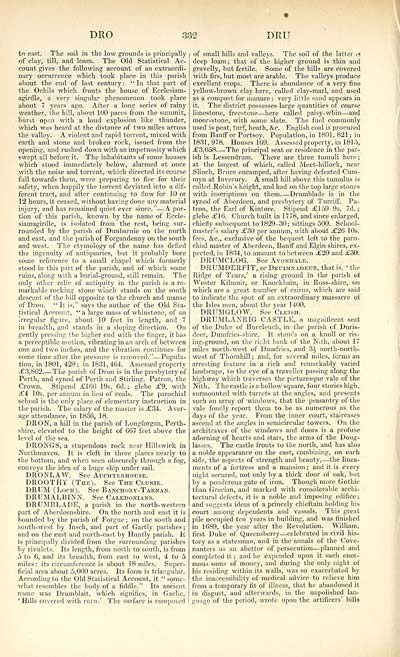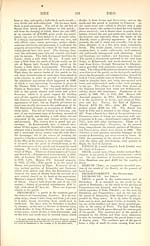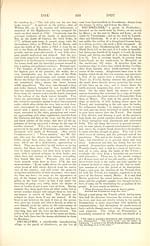Topographical, statistical, and historical gazetteer of Scotland > Volume 1
(414) Page 332 - DRO
Download files
Complete book:
Individual page:
Thumbnail gallery: Grid view | List view

DRO
332
D'RU
to east. The soil in the low grounds is principally
of clay, till, and loam. The Old Statistical Ac-
count gives the following account of an extraordi-
nary occurrence which took place in this parish
ahout the end of last century : " In that part of
the Ochils which fronts the house of Ecclesiam-
agirdle, a very singular phenomenon took place
about 7 years ago. After a long series of rainy
weather, the hill, about 100 paces from the summit,
burst open with a loud explosion like thunder,
which was heard at the distance of two miles across
the valley. A violent and rapid torrent, mixed with
earth and stone and broken rock, issued from the
opening, and rushed down with an impetuosity which
swept all before it. The inhabitants of some houses
which stood immediately below, alarmed at once
mth the noise and torrent, which directed its course
full towards them, were preparing to flee for their
safety, when happily the torrent deviated into a dif-
ferent tract, and after continuing to flow for 10 or
12 hours, it ceased, without having done any material
injury, and has remained quiet ever since." — A por-
tion of this parish, known by the name of Eccle-
siamagirdle, is isolated from the rest, being sur-
rounded by the parish of Dunbarnie on the north
and east, and the parish of Forgandenny on the south
and west. The etymology of the name has defied
the ingenuity of antiquaries, but it probably bore
some reference to a small chapel which formerly
stood in this part of the parish, and of which some
ruins, along with a burial-ground, still remain. The
only other relic of antiquity in the parish is a re-
markable rocking stone which stands on the south
descent of the hill opposite to the church and manse
of Dron. " It is," says the author of the Old Sta-
tistical Account, "a large mass of whinstone, of an
irregular figure, about 10 feet in length, and 7
in breadth, and stands in a sloping direction. On
gently pressing the higher end with the finger, it has
a perceptible motion, vibrating in an arch of between
one and two inches, and the vibration continues for
some time after the pressure is removed." — Popula-
tion, in 1801, 428 ; in 1831, 464. Assessed property
.£3,862— The parish of Dron is in the presbytery of
Perth, and synod of Perth and Stirling. Patron, the
Crown. Stipend £166 19s. 6d. ; glebe £9, with
£4 10s. per annum in lieu of coals. The parochial
school is the only place of elementary instruction in
the parish. The salary of the master is £34. Aver-
age attendance, in 1836, 18.
DRON, a hill in the parish of Longforgan, Perth-
shire, elevated to the height of 667 feet above the
level of the sea.
DRONGS, a stupendous rock near Hillswick in
Northmaven. It is cleft in three places nearly to
the bottom, and when seen obscurely through a fog,
conveys the idea of a huge ship under sail.
DRONLAW. See Auchterhouse.
DROOTHY (The). See The Clunie.
DRUM (Loch). See Banchory-Tarnan.
DRUMALBINN. See Caledonians.
DRUMBLADE, a parish in the north-western
part of Aberdeenshire. On the north and east it is
bounded by the parish of Forgue ; on the south and
south-west by Insch, and part of Gartly parishes;
and on the east and north-east by Huntly parish. It
is principally divided from the surrounding parishes
by rivulets. Its length, from north to south, is from
5 to 6, and its breadth, from east to west, 4 to 5
miles: its circumference is about 18 miles. Super-
ficial area about 5,000 acres. Its form is triangular.
According to the Old Statistical Account, it " some-
what resembles the body of a fiddle." Its ancient
name was Drumblait, which signifies, in Gaelic,
' Hills covered with corn.' The surface is composed
of small hills and valleys. The soil of the latter is
deep loam ; that of the higher ground is thin and
gravelly, but fertile. Some of the hills are covered
with firs, but most are arable. The valleys produce
excellent crops. There is abundance of a very fine
yellow-brown clay here, called clay-marl, and used
as a compost for manure : very little sand appears in
it. The district possesses large quantities of coarse
limestone, freestone — here called paisy-whin — and
moor-stone, with some slate. The fuel commonly
used is peat, turf, heath, &c. English coal is procured
from Banff or Portsoy. Population, in 1801, 821 ; in
1831,978. Houses 169. Assessed property, in 181.5,
£3,058 The principal seat or residence in the par-
ish is Lessendrum. There are three tumuli here ;
at the largest of which, called Meet-hillock, near
Slioch, Bruce encamped, after having defeated Cum-
myn at Inverury. A small hill above this tumulus is
called Robin's height, and had on the top large stones
with inscriptions on them Drumblade is in the
synod of Aberdeen, and presbytery of Turriff. Pa-
tron, the Earl of Kintore. Stipend £159 9s. 7d. ;
glebe £16. Church built in 1778, and since enlarged,
chiefly subsequent to 1829-30; sittings 500. School-
master's salary £30 per annum, with about £26 10s.
fees, &c, exclusive of the bequest left to the paro-
chial master of Aberdeen, Banff and Elgin shires, ex-
pected, in 1834, to amount to between £20 and £30.
DRUMCLOG. See Avondale.
DRUMDERFIT, or Druimnadeur, that is, ' the
Ridge of Tears,' a rising ground in the parish of
Wester Kilmuir, or Knockbain, in Ross-shire, on
which are a great number of cairns, which are said
to indicate the spot of an extraordinary massacre of
the Isles men, about the year 1400.
DRUMGLOW. See Cleish.
DRUMLANRIG CASTLE, a magnificent seat
of the Duke of Buccleuch, in the parish of Duris-
deer, Dumfries-shire. It stands on a knoll or ris-
ing-ground, on the rU'.ht bank of the Nith, about 1 7
miles north-west of Dumfries, and 3i north-north-
west of Thornhill ; and, for several miles, forms an
arresting feature in a rich and remarkably varied
landscape, to the eye of a traveller passing along the
highway which traverses the picturesque vale of the
Nith. The castle is a hollow square, four stories high,
surmounted with turrets at the angles, and presents
such an array of windows, that the peasantry of the
vale fondly report them to be as numerous as the
days of the year. From the inner court, staircases
ascend at the angles in semicircular towers. On the
architraves of the windows and doors is a profuse
adorning of hearts and stars, the arms of the Doug-
lasses. The castle fronts to the north, and has also
a noble appearance on the east, combining, on each
side, the aspects of strength and beauty, — the linea-
ments of a fortress and a mansion ; and it is every
night secured, not only by a thick door of oak, but
by a ponderous gate of iron. Though more Gothic
than Grecian, and marked with considerable archi-
tectural defects, it is a noble and imposing edifice ;
and suggests ideas of a princely chieftain holding his
court among dependents and vassals. This great
pile occupied ten years in building, and was finished
in 1689, the year after the Revolution. William,
first Duke of Queensberry— celebrated in civil his-
tory as a statesman, and in the annals of the Cove-
nanters as an abettor of persecution — planned and
completed it ; and he expended upon it such enor-
mous sums of money, and during the only night of
his residing within its walls, was so exacerbated by
the inaccessibility of medical advice to relieve hiin
from a temporary fit of illness, that he abandoned it
in disgust, and afterwards, in the unpolished lan-
guage of the period, wrote upon the artificers' bills
332
D'RU
to east. The soil in the low grounds is principally
of clay, till, and loam. The Old Statistical Ac-
count gives the following account of an extraordi-
nary occurrence which took place in this parish
ahout the end of last century : " In that part of
the Ochils which fronts the house of Ecclesiam-
agirdle, a very singular phenomenon took place
about 7 years ago. After a long series of rainy
weather, the hill, about 100 paces from the summit,
burst open with a loud explosion like thunder,
which was heard at the distance of two miles across
the valley. A violent and rapid torrent, mixed with
earth and stone and broken rock, issued from the
opening, and rushed down with an impetuosity which
swept all before it. The inhabitants of some houses
which stood immediately below, alarmed at once
mth the noise and torrent, which directed its course
full towards them, were preparing to flee for their
safety, when happily the torrent deviated into a dif-
ferent tract, and after continuing to flow for 10 or
12 hours, it ceased, without having done any material
injury, and has remained quiet ever since." — A por-
tion of this parish, known by the name of Eccle-
siamagirdle, is isolated from the rest, being sur-
rounded by the parish of Dunbarnie on the north
and east, and the parish of Forgandenny on the south
and west. The etymology of the name has defied
the ingenuity of antiquaries, but it probably bore
some reference to a small chapel which formerly
stood in this part of the parish, and of which some
ruins, along with a burial-ground, still remain. The
only other relic of antiquity in the parish is a re-
markable rocking stone which stands on the south
descent of the hill opposite to the church and manse
of Dron. " It is," says the author of the Old Sta-
tistical Account, "a large mass of whinstone, of an
irregular figure, about 10 feet in length, and 7
in breadth, and stands in a sloping direction. On
gently pressing the higher end with the finger, it has
a perceptible motion, vibrating in an arch of between
one and two inches, and the vibration continues for
some time after the pressure is removed." — Popula-
tion, in 1801, 428 ; in 1831, 464. Assessed property
.£3,862— The parish of Dron is in the presbytery of
Perth, and synod of Perth and Stirling. Patron, the
Crown. Stipend £166 19s. 6d. ; glebe £9, with
£4 10s. per annum in lieu of coals. The parochial
school is the only place of elementary instruction in
the parish. The salary of the master is £34. Aver-
age attendance, in 1836, 18.
DRON, a hill in the parish of Longforgan, Perth-
shire, elevated to the height of 667 feet above the
level of the sea.
DRONGS, a stupendous rock near Hillswick in
Northmaven. It is cleft in three places nearly to
the bottom, and when seen obscurely through a fog,
conveys the idea of a huge ship under sail.
DRONLAW. See Auchterhouse.
DROOTHY (The). See The Clunie.
DRUM (Loch). See Banchory-Tarnan.
DRUMALBINN. See Caledonians.
DRUMBLADE, a parish in the north-western
part of Aberdeenshire. On the north and east it is
bounded by the parish of Forgue ; on the south and
south-west by Insch, and part of Gartly parishes;
and on the east and north-east by Huntly parish. It
is principally divided from the surrounding parishes
by rivulets. Its length, from north to south, is from
5 to 6, and its breadth, from east to west, 4 to 5
miles: its circumference is about 18 miles. Super-
ficial area about 5,000 acres. Its form is triangular.
According to the Old Statistical Account, it " some-
what resembles the body of a fiddle." Its ancient
name was Drumblait, which signifies, in Gaelic,
' Hills covered with corn.' The surface is composed
of small hills and valleys. The soil of the latter is
deep loam ; that of the higher ground is thin and
gravelly, but fertile. Some of the hills are covered
with firs, but most are arable. The valleys produce
excellent crops. There is abundance of a very fine
yellow-brown clay here, called clay-marl, and used
as a compost for manure : very little sand appears in
it. The district possesses large quantities of coarse
limestone, freestone — here called paisy-whin — and
moor-stone, with some slate. The fuel commonly
used is peat, turf, heath, &c. English coal is procured
from Banff or Portsoy. Population, in 1801, 821 ; in
1831,978. Houses 169. Assessed property, in 181.5,
£3,058 The principal seat or residence in the par-
ish is Lessendrum. There are three tumuli here ;
at the largest of which, called Meet-hillock, near
Slioch, Bruce encamped, after having defeated Cum-
myn at Inverury. A small hill above this tumulus is
called Robin's height, and had on the top large stones
with inscriptions on them Drumblade is in the
synod of Aberdeen, and presbytery of Turriff. Pa-
tron, the Earl of Kintore. Stipend £159 9s. 7d. ;
glebe £16. Church built in 1778, and since enlarged,
chiefly subsequent to 1829-30; sittings 500. School-
master's salary £30 per annum, with about £26 10s.
fees, &c, exclusive of the bequest left to the paro-
chial master of Aberdeen, Banff and Elgin shires, ex-
pected, in 1834, to amount to between £20 and £30.
DRUMCLOG. See Avondale.
DRUMDERFIT, or Druimnadeur, that is, ' the
Ridge of Tears,' a rising ground in the parish of
Wester Kilmuir, or Knockbain, in Ross-shire, on
which are a great number of cairns, which are said
to indicate the spot of an extraordinary massacre of
the Isles men, about the year 1400.
DRUMGLOW. See Cleish.
DRUMLANRIG CASTLE, a magnificent seat
of the Duke of Buccleuch, in the parish of Duris-
deer, Dumfries-shire. It stands on a knoll or ris-
ing-ground, on the rU'.ht bank of the Nith, about 1 7
miles north-west of Dumfries, and 3i north-north-
west of Thornhill ; and, for several miles, forms an
arresting feature in a rich and remarkably varied
landscape, to the eye of a traveller passing along the
highway which traverses the picturesque vale of the
Nith. The castle is a hollow square, four stories high,
surmounted with turrets at the angles, and presents
such an array of windows, that the peasantry of the
vale fondly report them to be as numerous as the
days of the year. From the inner court, staircases
ascend at the angles in semicircular towers. On the
architraves of the windows and doors is a profuse
adorning of hearts and stars, the arms of the Doug-
lasses. The castle fronts to the north, and has also
a noble appearance on the east, combining, on each
side, the aspects of strength and beauty, — the linea-
ments of a fortress and a mansion ; and it is every
night secured, not only by a thick door of oak, but
by a ponderous gate of iron. Though more Gothic
than Grecian, and marked with considerable archi-
tectural defects, it is a noble and imposing edifice ;
and suggests ideas of a princely chieftain holding his
court among dependents and vassals. This great
pile occupied ten years in building, and was finished
in 1689, the year after the Revolution. William,
first Duke of Queensberry— celebrated in civil his-
tory as a statesman, and in the annals of the Cove-
nanters as an abettor of persecution — planned and
completed it ; and he expended upon it such enor-
mous sums of money, and during the only night of
his residing within its walls, was so exacerbated by
the inaccessibility of medical advice to relieve hiin
from a temporary fit of illness, that he abandoned it
in disgust, and afterwards, in the unpolished lan-
guage of the period, wrote upon the artificers' bills
Set display mode to: Large image | Transcription
Images and transcriptions on this page, including medium image downloads, may be used under the Creative Commons Attribution 4.0 International Licence unless otherwise stated. ![]()
| Gazetteers of Scotland, 1803-1901 > Topographical, statistical, and historical gazetteer of Scotland > Volume 1 > (414) Page 332 - DRO |
|---|
| Permanent URL | https://digital.nls.uk/97442514 |
|---|
| Description | Volume first. A-H. |
|---|---|
| Attribution and copyright: |
|

